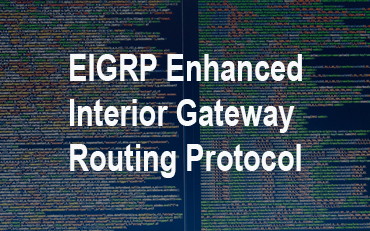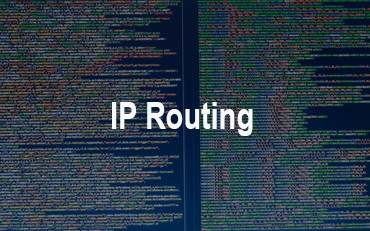EIGRP Enhanced Interior Gateway Routing Protocol
Enhanced Interior Gateway Routing Protocol (EIGRP) is a Cisco proprietary protocol.
Multiple paths to destination.
Cisco proprietary protocol that is Work only with Cisco Router
Supports IP, IPX, Appletalk.
Multiple autonomous systems in same router.
AD is 90.
Route is ‘D’.
classless routing , distance vector protocol
communicates with other routers via, RTP ( Reliable Transport Protocol )
selects the best path via Diffusing update algorithm ( DUAL )
Supports multiple autonomous system on a single router
Supports VLSM and summarization
Metric – bandwidth, delay ,load and reliability
Used in large network
Multiple network layer protocol
Max hop count is 255 (100 by default)
Hello packets are send in every 5 seconds
Each EIGRP router uses three tables to store routing information:
Neighbor table – stores information about EIGRP neighbors
Topology table – stores routing information learned from neighbor routing tables.
Routing table – stores only the best routes to reach a remote network.
Some Terminology used in EIGRP.
DUAL ( Diffused Update Algorithm) this is a algorithm used for calculating the shortest path.
Neighbor table : EIGRP use hello packets to discover neighbors. It contains neighbor’s address and the interface through which it can be reached in .
Topology table : each router stores its neighbors routing tables in its EIGRP topology table
Successor is a neighboring router that has a least-cost path to a destination
Feasible successor is the next-hop router for a backup path.
Routing table contains all of the successor routes from the topology table.
Advertised distance is the distance between a neighbouring router to the specific router.
Feasible distance is the best route to reach a destination network.
Enhanced Interior Gateway Routing Protocol (EIGRP)
considering we have configure Hostname and IP address in Router01,Router03,Router03
Please refer how to configure Hostname and IP address in Router01,Router03,Router03 by clicking here.
Enhanced Interior Gateway Routing Protocol (EIGRP) configuration in Router01
Router01>enable Router01#configure terminal Enter configuration commands, one per line. End with CNTL/Z. Router01(config)#router eigrp 1 Router01(config-router)#network 172.16.0.0 Router01(config-router)#network 172.17.0.0 Router01(config-router)#exit Router01(config)#exit Router01#
Enhanced Interior Gateway Routing Protocol (EIGRP) configuration in Router02
Router02>enable Router02#configure terminal Enter configuration commands, one per line. End with CNTL/Z. Router02(config)#router eigrp 1 Router02(config-router)#network 172.17.0.0 Router02(config-router)#network 172.18.0.0 Router02(config-router)#network 172.19.0.0 Router02(config-router)#exit Router02(config)#exit Router02#
Enhanced Interior Gateway Routing Protocol (EIGRP) configuration in Router03
Router03>enable Router03#configure terminal Enter configuration commands, one per line. End with CNTL/Z. Router03(config)#router eigrp 1 Router03(config-router)#network 172.19.0.0 Router03(config-router)#network 172.20.0.0 Router03(config-router)#exit Router03(config)#exit Router03#
view the routing table in Router01
Router01>enable Router01#show ip route Codes: C - connected, S - static, I - IGRP, R - RIP, M - mobile, B - BGP D - EIGRP, EX - EIGRP external, O - OSPF, IA - OSPF inter area N1 - OSPF NSSA external type 1, N2 - OSPF NSSA external type 2 E1 - OSPF external type 1, E2 - OSPF external type 2, E - EGP i - IS-IS, L1 - IS-IS level-1, L2 - IS-IS level-2, ia - IS-IS inter area * - candidate default, U - per-user static route, o - ODR P - periodic downloaded static route Gateway of last resort is not set C 172.16.0.0/16 is directly connected, FastEthernet0/0 C 172.17.0.0/16 is directly connected, Serial0/0 D 172.18.0.0/16 [90/2172416] via 172.17.0.2, 00:05:36, Serial0/0 D 172.19.0.0/16 [90/2681856] via 172.17.0.2, 00:05:30, Serial0/0 D 172.20.0.0/16 [90/2684416] via 172.17.0.2, 00:02:35, Serial0/0
view the routing table in Router02
Router02>enable Router02#show ip route Codes: C - connected, S - static, I - IGRP, R - RIP, M - mobile, B - BGP D - EIGRP, EX - EIGRP external, O - OSPF, IA - OSPF inter area N1 - OSPF NSSA external type 1, N2 - OSPF NSSA external type 2 E1 - OSPF external type 1, E2 - OSPF external type 2, E - EGP i - IS-IS, L1 - IS-IS level-1, L2 - IS-IS level-2, ia - IS-IS inter area * - candidate default, U - per-user static route, o - ODR P - periodic downloaded static route Gateway of last resort is not set D 172.16.0.0/16 [90/2172416] via 172.17.0.1, 00:08:02, Serial0/0 C 172.17.0.0/16 is directly connected, Serial0/0 C 172.18.0.0/16 is directly connected, FastEthernet0/0 C 172.19.0.0/16 is directly connected, Serial0/1 D 172.20.0.0/16 [90/2172416] via 172.19.0.2, 00:04:45, Serial0/1
view the routing table in Router03
Router03>enable Router03#show ip route Codes: C - connected, S - static, I - IGRP, R - RIP, M - mobile, B - BGP D - EIGRP, EX - EIGRP external, O - OSPF, IA - OSPF inter area N1 - OSPF NSSA external type 1, N2 - OSPF NSSA external type 2 E1 - OSPF external type 1, E2 - OSPF external type 2, E - EGP i - IS-IS, L1 - IS-IS level-1, L2 - IS-IS level-2, ia - IS-IS inter area * - candidate default, U - per-user static route, o - ODR P - periodic downloaded static route Gateway of last resort is not set D 172.16.0.0/16 [90/2684416] via 172.19.0.1, 00:06:01, Serial0/1 D 172.17.0.0/16 [90/2681856] via 172.19.0.1, 00:06:01, Serial0/1 D 172.18.0.0/16 [90/2172416] via 172.19.0.1, 00:06:01, Serial0/1 C 172.19.0.0/16 is directly connected, Serial0/1 C 172.20.0.0/16 is directly connected, FastEthernet0/0
Verify the connectivity between networks using the ping command
Now we can run ping from Host01 (IP address: 172.16.0.10/16) to Host03 (IP address: 172.20.0.10/16) for verification.
C:\>ping 172.20.0.10 Pinging 172.20.0.10 with 32 bytes of data: Reply from 172.20.0.10: bytes=32 time=172ms TTL=125 Reply from 172.20.0.10: bytes=32 time=188ms TTL=125 Reply from 172.20.0.10: bytes=32 time=157ms TTL=125 Reply from 172.20.0.10: bytes=32 time=188ms TTL=125
The ping reply from Host03 (IP address: 172.20.0.10/16) shows that the Enhanced Interior Gateway Routing Protocol (EIGRP) Protocol is configured well in three routers and there is network connectivity between different networks.
You May Also Enjoy Reading This …





